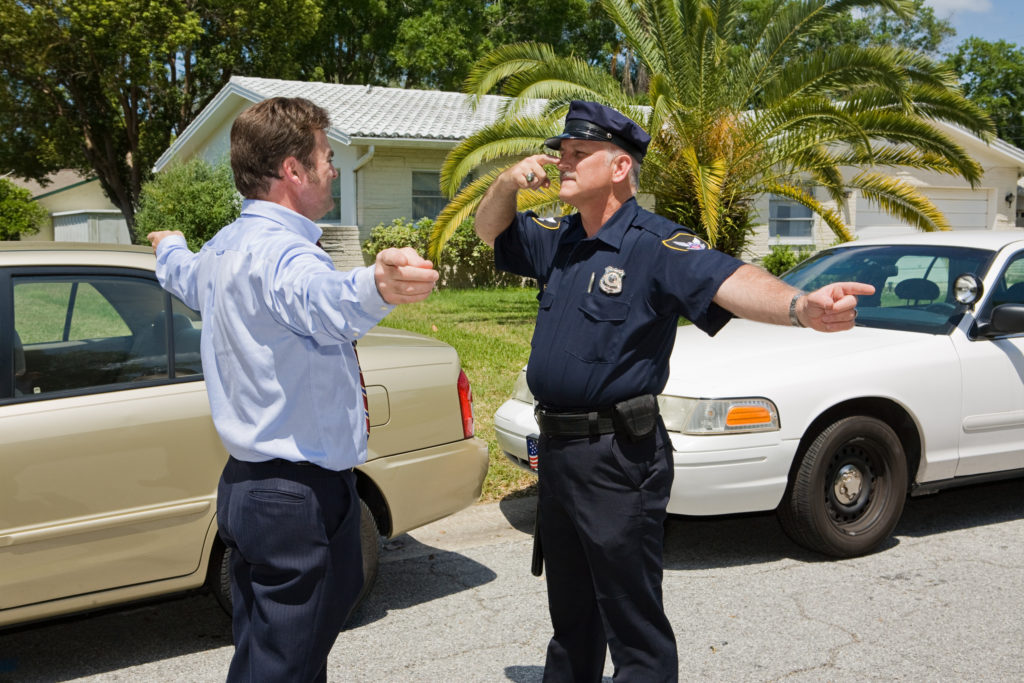Welcome back and thanks for joining us again as we break down Michigan’s field sobriety tests, which a number of our clients have described as the world’s scariest pop quiz. And who could blame them – it’s hard to prepare for a test that you have no idea you’ll be taking, and no way to know what questions you’ll be asked. Actually, that last part should be less of an issue for you in the future, as that’s exactly what we’re doing here – letting you in on the questions!
In the first two sections we explained the horizontal gaze nystagmus test and the walk-and-turn test, both of which are very common roadside sobriety tests. But they aren’t the only two! Another one that’s regularly used by police officers here in Michigan is the one-leg-stand-test.
The One-Leg-Stand Test (OLS)
The one-leg-stand test is pretty much what it sounds like – the officer asks you to stand on one leg, with one foot raised about six inches off the ground, and count aloud by one thousands until the officer says you’re done. For most sober people in decent shape and without medical conditions, this would be a cinch. However, once you’ve introduced alcohol into your brain, simple things get a lot harder to do.
Like the walk-and-turn test, this is a divided attention test. The goal here is to make sure that you can successfully follow different instructions at the same time – in this case: standing on one foot (specified by the officer) and counting out loud in a specific way. The test usually lasts for about 30 seconds. During this half minute, the officer will be watching for specific signs of intoxication:
- Swaying from side to side while balancing,
- Using your arms to maintain your balance,
- Hopping on one foot in order to stay upright,
- Putting your foot down before the 30 second time limit is up.
According to the National Highway Traffic Safety Administration, this test is 83 percent accurate. However, while the previous three tests may be the most common ones you’ll encounter, there are several others that officers use as well.
The Rhomberg Balance Test
In this test the officer asks you to stand up straight with your eyes closed and your head tilted back. You are then required to stay in that position and silently estimate how long it would take for about 30 seconds to elapse. The simple answer to this dilemma, of course, is just to tip your head back, close your eyes, and count to 30 in your head. Simple right? Well, perhaps if you’re sober. But if you’ve been drinking it can be lot tougher to achieve.
Keeping your balance with your eyes closed and your head tipped back is very hard to do if you’re under the influence of alcohol. Now add to that challenge the difficulty of keeping track of time without counting out loud. All in all, this can be a very difficult test. (Even more so for people who are under the influence of drugs) While the officer is watching you, he will also be keeping an eye out for other signs of intoxication, like:
- The inability to stand steadily
- Uncontrollable eyelid tremors
- The need to sneak a peek in order to maintain your balance
- Muscle tension,
- Inaccuracy in your internal clock. (It will be slow if you’re drunk, and too fast if you’re on stimulants.)
Join us next time as we wrap up this in-depth look at the roadside sobriety test in Michigan, and the many variations you could be up against if you’re ever pulled over for suspected drunk driving in the Great Lakes State. Until then, if you or a loved one have been accused of driving under the influence of alcohol, or have been arrested for drugged driving, call The Kronzek Firm immediately at 866 766 5245. Our trusted drunk driving defense attorneys have decades of experience protecting the people of Michigan against drunk driving charges. We are here to help you.




